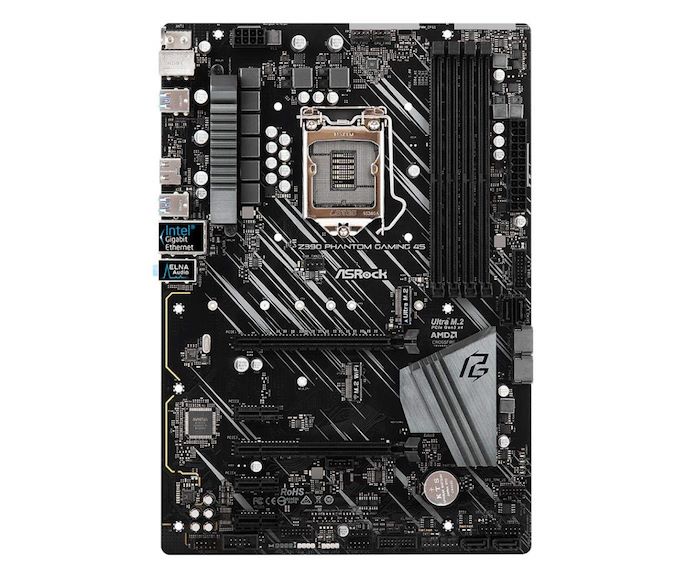The ASRock Z390 Phantom Gaming 4S Motherboard: An 8-Phase Board With M.2 For $118
by Gavin Bonshor on May 15, 2019 9:15 AM EST- Posted in
- Motherboards
- Intel
- ASRock
- ATX
- Z390
- Phantom Gaming 4S
_678x452.png)
In a relatively quiet launch, ASRock has added another model to its Phantom Gaming series of motherboards: the new ATX sized ASRock Z390 Phantom Gaming 4S. The Z390 Phantom Gaming 4S represents a modest entry-level offering onto the chipset with a single M.2 slot, six SATA ports, and a 1 GbE NIC.
The main focal point of the ASRock Z390 Phantom Gaming 4S is to provide users with a cost-effective and entry-level option onto Intel's Z390 chipset without breaking the bank. On the controller front, the Z390 Phantom Gaming 4S makes use of the more affordable Intel I219V 1 GbE NIC, with the option to add wireless capability through a single M.2 Key E 2230 slot; this uses the Z390 chipset's native CNVi. Also included is a Realtek ALC1200 HD audio codec with ELNA, which adds three 3.5 mm audio jacks on the rear panel.
While the ASRock Z390 Phantom Gaming 4S doesn't support NVIDIA SLI across it's two full-length PCIe 3.0 slots (x16/x4), two-way AMD CrossFire multi-graphics card configurations can be utilized. The board also has three PCIe 3.0 x1 slots, as well as a single M.2 22110 slot with support for NVMe boot drives, and six SATA ports capable of supporting RAID 0, 1, 5 and 10 arrays. On the rear panel is two PS/2 combo ports for legacy keyboards and mice, as well as four USB 3.1 Gen1 Type-A ports, two USB 2.0 ports, and a single HDMI 1.4 video output.
On the performance front, the ASRock Z390 Phantom Gaming 4S features an 8-phase power delivery with a single 8-pin 12 V EPS power connector. The CPU VCore section of the power delivery features a slimline aluminium heatsink, while the SoC area relies on passive cooling across the MOSFETs. Memory support is impressive with DDR4-4300 RAM supported with a maximum capacity of 128 GB across four available memory slots.
As it stands, the ASRock Z390 Phantom Gaming 4S is currently available at Amazon for an attractive price of $118, with the slightly lower Z390 Phantom Gaming 4 model available for just $100 on Newegg. With the ASRock Phantom Gaming range of motherboards and graphics cards is primarily targetted at the mid to high-end gamers, this marks a noticeably different approach from ASRock with the company looking to extend its Phantom Gaming series across all of the different pricing brackets.
Related Reading
- 28 Cores in Mini-ITX: ASRock Rack EPC621D4I-2M Motherboard for Xeon Scalable
- GIGABYTE X470 Aorus Gaming 7 WiFi-50 Motherboard Launched: Celebrating AMD's 50th Anniversary
- COLORFUL CVN-Z390M Gaming V20 Motherboard: All Aboard The Flight Deck
- The GIGABYTE Z390 Aorus Pro WIFI Motherboard Review: A Sturdy $200 Surprise
- The Intel 9th Gen Review: Core i9-9900K, Core i7-9700K and Core i5-9600K Tested



_thumb.png)

_thumb.png)
_thumb.png)









9 Comments
View All Comments
JoeyJoJo123 - Wednesday, May 15, 2019 - link
Pretty good value overall for just over $100. I've tended to stick to lower priced Z-series MSI/Gigabyte/AsRock boards for Intel unlocked and overclockable CPUs in the past. (Asus board quality is nice, too, but their cheapest models are often much more expensive than the competition.) If I was on the market for an ATX Z390 board, this would be a contender.For an Intel CPU for a typical PC gaming setup, you really just need a Z-series chipset for overclocking, adequate I/O, adequate VRMs (to match with an adequate value-minded heatsink, like the Cryorig H7, Hyper 212-series, Reeven Justice, Thermalright True Spirit, etc. to get a good enough overclock), and good user reviews.
If you're in the price range where an unlocked Intel + Z-series motherboard doesn't make financial sense for your budget, it's better to just go with a value-minded AMD CPU + B450 board anyways, since you'll still retain the ability to overclock these lower priced CPUs with those lower priced boards anyways, and you'd still have a forward-looking upgrade path for higher core count CPUs in the future.
Irata - Wednesday, May 15, 2019 - link
And higher thread count* even at the same cores if security is your thing it appears.*referring to ZombieLoad
JoeyJoJo123 - Wednesday, May 15, 2019 - link
Just learned about ZombieLoad/RIDL/Fallout minutes ago. Kinda too bad for AsRock here since the majority of the Intel chips this board is supposed to serve are now really poor choices in terms of security.liu_d - Wednesday, May 15, 2019 - link
Well, 6+2 phase. Calling it an 8-phase board is a little dishonest.AshlayW - Thursday, May 16, 2019 - link
What's funny is I THINK that's actually 3+2 phase, with two inductors per phase on the CPU side. Basically every CPU side VRM with "6" phases on these budget boards from Asrock is actually a three phase with doubled inductors to make it look "beefier" afaik.. At least their Ryzen boards are... They could have easily stuck with a single, larger spec inductor and just had three of them, but of course marketing is marketing!Oxford Guy - Friday, May 17, 2019 - link
Buildzoid appears to be the source to go to to find out what the VRM configuration really is. These companies are so sueable but no one bothers.Oxford Guy - Friday, May 17, 2019 - link
It's funny that there are frivolous lawsuits, like suing AMD over Bulldozer for core count, and yet lawsuits that absolutely should happen don't.Blatant fraud has been happening with the VRM count for years.
nobozos - Wednesday, May 15, 2019 - link
"doesn't support NVIDIA SLI across it's two full-length PCIe 3.0 slots " ->"doesn't support NVIDIA SLI across its two full-length PCIe 3.0 slots "
Bulat Ziganshin - Wednesday, May 15, 2019 - link
I wonder that they cut in $100 mobo?